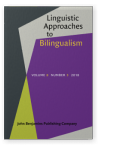Vol. 8:3 (2018) ► pp.283–319
Effects of education on the production of plural morphology among bilingual speakers of Yucatec Maya and Spanish
Yucatec Maya differs from many better-known languages in that it has optional plural marking. In a psycholinguistic study of the production of optional plural marking with college-enrolled speakers of Yucatec Maya, Butler, Jaeger, and Bohnemeyer (2014) found that conceptual number information influences the production of optional plural marking. Since the participants in the Butler et al. (2014) study are not necessarily representative of speakers of Yucatec Maya, we examine the effects of conceptual number information, via the manipulation of set size, while factoring in the effects of age, education and language use variables on the production of optional plural morphology among bilingual speakers of Yucatec Maya and Spanish speaking in Yucatec Maya. In addition to finding effects of conceptual information, we found that education, but not age, significantly influences the production of plural morphology in Yucatec Maya. Participants with higher levels of education were more sensitive to conceptual number information.
Article outline
- 1.Introduction
- 1.1Production of number marking and agreement
- 1.2Acquisition of number marking
- 1.3Bilingual sentence processing
- 1.4Bilingualism in the Yucatan Peninsula
- 1.5Previous findings, goals and predictions of present study
- 2.Methods
- 2.1Participants
- 2.2Procedure
- 2.3Materials
- 2.4Coding and exclusions
- 3.Analysis
- 3.1Set size
- 3.2Education and age
- 3.3Language use variables
- 3.4Matching plural agreement
- 3.5Interaction of set size and level of education
- 4.Discussion
- 4.1Conceptual and grammatical number information
- 4.2Role of education
- 4.3Conclusions
- Acknowledgments
- Notes
- Appendices
- Yucatec Maya number marking and agreement
-
References
